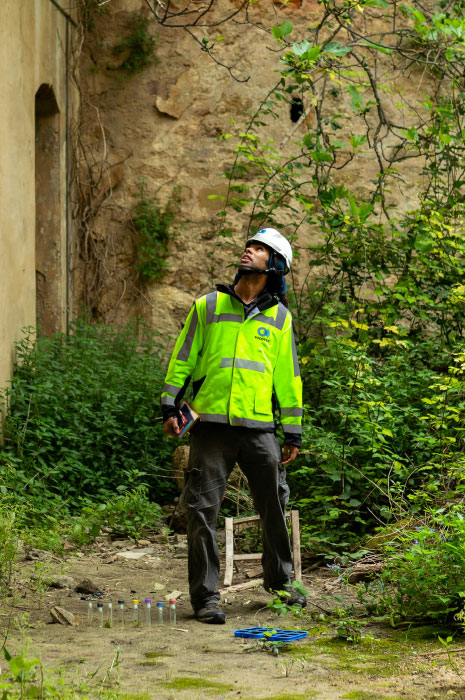Environmental impact in Civil Engineering projects
Most Civil Engineering projects involve a modification of the soil and its properties. For this reason, in all phases of execution, respecting the environment is essential to preserve biodiversity and the conservation of the environment. At SOCOTEC, we are keenly aware of our responsibility and want to leave a positive and lasting impact on the planet. That is why environmental considerations and environmental assessment have been integrated into all departments of our company, ensuring that every project we undertake is sustainable.

The environmental impact of construction
As we mentioned, any type of construction, from the construction of roads to buildings, can have negative effects on the environment. In this sense, both the effects produced during construction and those caused by the structure itself must be taken into account:
- Air and water pollution: Any type of construction can generate greenhouse gas emissions and polluting particles that can affect both air and water quality. Ultimately, they can also have a negative impact on the environment and human health.
- Erosion and landslides: A building project usually requires the removal of earth and rock, which can lead to erosion and landslides.
- Destruction or deterioration of natural habitats: Some civil engineering projects may require the felling of trees and the affectation of natural areas, which can undermine biodiversity.
It is essential to take these potential adverse effects into account before carrying out any construction or renovation, as well as to take the necessary measures to minimise them. For all these reasons, EIA in projects of all kinds, whether private or from the environmental body of the public administration, is key.
What does an Environmental Impact Study (EIA) consist of?
The preparation of an environmental impact report is a technical and administrative process that seeks to identify, predict, evaluate and mitigate the potential environmental effects of a project before its execution. This study usually includes a description of the project, a description of the environment, the identification and evaluation of the impacts, the mitigation measures and the Environmental Management Plan.
In short, the Environmental Impact Study is a fundamental tool for strategic environmental assessment in decision-making and is used to ensure that development projects, such as civil engineering projects, are carried out in a sustainable manner and with the least possible impact on the environment and society.
At SOCOTEC, we are clear that both natural resources, sustainability and the circular economy are fundamental requirements in today's engineering. That is why the projects we lead are always carried out with prior environmental consultancies to minimise the impact of infrastructures on the environment and on the increasingly visible climate change. We have the technical expertise to carry out an environmental assessment (water, air, soil) and discover its state of conservation in order to properly design the necessary preventive or mitigation measures.
Our types of technical field analysis are:
- Environmental impact assessment of infrastructures and services
- The design of preventive, mitigating and compensatory measures
- The efficiency analysis of corrective measures
- The monitoring of any of the environmental aspects of a project.
ENVIRONMENTAL IMPACT STUDY
The obligation to carry out an Environmental Impact Assessment (EIA) and the preparation of an environmental impact statement (EIS) varies according to the law of each country, but generally, it is mandatory in the following situations:

How does EIA assess?
In Spain, the Environmental Impact Assessment (EIA) process begins with the determination of the need for the EIA for projects according to their potential impact (Law 21 2013 of 9 December). The promoter submits an Initial Project Document and, after prior consultations, prepares a detailed Environmental Impact Study. This study is subject to public information and consultations, after which the environmental authority issues an Environmental Impact Report. The resulting Environmental Impact Statement can be favorable or unfavorable, depending on compliance with environmental requirements. If favorable, the implementation of mitigation and environmental monitoring measures is supervised.
Law 21 2013 of 9 December on environmental assessment
In Spain, the obligation to carry out an Environmental Impact Study (EIA) is mainly regulated by Law 21/2013, of 9 December, on Environmental Assessment. If you have any doubts or do not know whether or not your project should carry out an environmental assessment, do not hesitate to contact us.
Who must issue the environmental impact statement?
The environmental impact statement (EIS) must be issued by those responsible for the competent environmental assessment of the country or region where the project is being developed. This authority may vary depending on the jurisdiction and its own environmental laws, but generally includes National Environment Agencies, Ministries of the Environment, Regional or Local Governments and Specialized Bodies. These are usually responsible for issuing an Environmental License that gives the green light to the execution of the project in question.
Green infrastructure, an option for the future
At SOCOTEC we are experts in designing solutions that minimise negative effects on the environment, society and the economy. That is why we work every day to develop innovative solutions that allow us to continue to be at the forefront of our sector. Currently, green and green infrastructure plays a critical role in reducing the environmental impact of construction projects, providing a number of ecological, social, and economic benefits. That is why we have opted for its integration into the design and management of buildings, which allows us to create more sustainable, resilient and habitable urban environments.
Green infrastructure refers to a network of natural and semi-natural spaces designed and managed to provide a wide range of ecosystem services, such as improving air and water quality, regulating climate and supporting biodiversity. In the context of construction, it can include a multitude of elements such as green roofs, vertical gardens, urban parks, sustainable drainage systems and conservation areas. These types of elements help mitigate the negative effects of construction by integrating with the natural environment, which provides a multitude of health benefits, improves biodiversity in urban areas and regulates the climate.
At SOCOTEC, with our sustainability certificate , we are committed to efficient and environmentally friendly solutions, such as green infrastructures, which are increasingly necessary. In a time of climate urgency such as the one we are experiencing, carrying out actions that allow us to achieve environmental, social and economic sustainability is no longer an option, but a requirement.
Do you want us to advise you on environmental consulting services?

You might also be interested...




